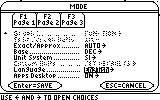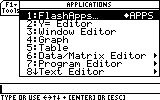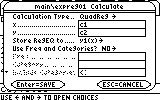Saturday, September 30, 2006
Overview of Working With Functions on TI-89
Friday, September 29, 2006
Assignment 10: 3.2.44, 3.2.59, and TMP(10b)
For number 44 in 3.2, we were to answer questions about a piecewise g(x) function. I was able to answer it, and did so by graphing, but my calculator wouldn't let me type the rule -1<=x<=2 into the "y=" screen. When we are graphing things like y= 2x-3 | x<-1 or y= |x|-5 | -1<=x<=2 can we only include a one-sided inequality? Am I typing something wrong?
For number 59 in 3.2, I knew that to find the domain, I had to solve (x-9)^2 <= 9 (since what's inside the square root sign must be greater than or equal to zero). These were the steps of my solution:
(x-9)^2<=9
|x-9|<=sq.rt.(9)
x-9<=3 and x-9<= -3
x<=6 and x<=12
However, the solution the book gave is [6,12], meaning that I should have gotten x>=6. Where should I have switched the direction of the inequality sign? I am sure there's an easier way to solve this on a calculator, but I'm just curious to find my mistake.
For 10b on the TMP sheet, I am just really confused about how to approach it. In the third row of the table, I got a final result of y=(x^2/4)-5. And if I made the changes given in 10b, the final result would be y=(0.5(x-k))^2+x-4. I tried setting these two equations equal to one another on my calculator and solving for k, but I got a complicated sq.rt. answer with x involved. Did anyone find an actual numerical value for k?
Thanks guys
Wednesday, September 27, 2006
response to #5
SECRET BONUS DIAMOND SURPRISE!
Sunday, September 24, 2006
#5 practice test
14c on practice test
problem 14
Tangent Lines to Parabola
Absolute Max/Min vs. Relative Max/Min
For example, in practice test no calculator section, #4a find the approximate max on [-5,5]. What is the correct answer, (5,500) or (-1,130)?
Continue #4, 4b, is there a absolute max value? and the same thing on the "I didn't want to go to the talk" sheet, #4a-4d.
Saturday, September 23, 2006
Practice Test Questions
For #12 how do you make x=0 at 1990 in the data matrix program?
For 14c how do you find the minimum? I got y1=x^2 +800,000/x and graphed it but had trouble finding an upper bound in order to use the minimum function in the math menu.
How do you solve #16. I know you use the distance formula and set it equal to 4 but i'm not sure how to set up the rest of the equation.
Last year's test
Friday, September 22, 2006
Apps Desktop on TI-89
To toggle the Apps Desktop on and off you can go to Menu screen, and all the way at the bottom is an option to control it.

Basically the only difference seems to be how it looks visually and how long it takes to find something. In the Apps Desktop mode you just have to find the icon of the program that you're looking for, and press enter to run it. However, all the programs show up in this screen.

When you have Apps Desktop turned off however, you are presented with the all too familiar drop-down list.

The only difference is that its organized into a list, and the Flash applications are separated from the rest, but you can use Diamond+Apps to go directly there. The reason I personally leave the desktop turned though is because i can just hit the number of the program I want to launch without scrolling around. For instance to get directly to the Data/Matrix Editor, you can just type in "6."
Thursday, September 21, 2006
Setting Up Scatter Plots and Linear Regression Problems
Monday, September 18, 2006
assignment 6
-sarah iqbal
2.4#21
If you want to find a good window...
what is the best way to set up this problem, concerning the fact that the height is at least 3?
Sunday, September 17, 2006
The way I find windows
Tricks for finding windows?
#11 of 2.4
Number 9
for summation do as follows-- [sigma symbol](variable expression,variable,lower limit,upperlimit)
Graphing Window Find Tricks
How Do I solve Problems Like problems 2.3:31 Correctly
Quiz #1-1B
How to Perform a Quadratic Regression on a TI-89
Open up Apps > Data/Matrix Editor > New, type in something under variable, and press Enter. Note: Variable names cannot match system variables (such as linreg, expreg, quadreg).

Next you have to enter in a set of data, so let's just use the sample dataset
| time | population |
| c1 | c2 |
| 1 | 1 |
| 2 | 4 |
| 3 | 9 |
| 4 | 16 |
| 5 | 25 |
| 6 | 36 |
| 7 | 49 |
| 8 | 64 |
| 9 | 81 |
| 10 | 100 |
An easy way to type this set of data in would be enter the 1-10 under "c1", and then if you go over and highlight "c2", type in "c1^2," and the "c2" column will be populated with the squares of the "c1" values.
Now go to F2 > Plot 1 > F1. Under "Plot Type" choose scatter, under "x" and "y" put "c1" and "c2" respectively, and press Enter.
When you're back at the Data/Matrix Editor screen, go to F5, and change "Calculation Type" to "QuadReg." Once again for "x" and "y" enter in "c1" and "c2" respectively, under "Store RegEQ to," choose "y1(x)," and press Enter.
Now we just have to set a window for this graph, so let's use 0 for x-min and y-min, 10 for x-max, and 100 for y-max.
So that's how to do a quadratic regression, but how about if we wanted to do the same for an exponential or cubic function. Below is a table listing a few common regressions, and under the Calculate (F5) screen, you can just change which one you enter.
| Type | Command | Formula |
| Cubic Regression | CubicReg | y=ax^3+bx^2+cx+d |
| Exponential Regression | ExpReg | y=ab^x |
| Linear Regression | LinReg | y=a+bx |
| Logarithmic Regression | LnReg | y=a+b(ln(x)) |
| Power Regrssion | PowerReg | y=ay=ax^b |
| Quadratic Regression | QuadReg | y=ax^2+bx+c |
Friday, September 15, 2006
Problems of the Week & Scavenger Hunts
- No collaboration.
- Research is okay, but must be correctly documented.
- Each correct answer is worth +2 points on a test.
- Answers to be handed in, on paper, by Friday, September 22
Ready?
- How is “modal logic” different from ordinary logic?
- Four positive integers are given. Take the mean of three of the integers and add it to the fourth. The four possible results are 29, 23, 21, 17. What are the original integers?
- What is the Cantor Set?
- Increasing the radius of a cylinder 6 units increases its volume by y cubic units. Increasing its height by 6 units would also increase its volume by y cubic units. If the original height is 2 units, what is the original radius?
Wednesday, September 13, 2006
My TI-89 didn't simplify...
Also, in response to Carrie's blog, if part of what you are asking is whether you can program your TI-89 to always give an exact answer, I think you can do this by going to the MATH menu, scrolling down to the exact/approximate row, and choosing "exact". However, you might be referring to a way to get exact answers by typing in approximations, in which case I can't be of much help.
Ti-89 Approx v. Exact Answers
Ex. Enter in 1.73205(approx) and get out sqrt(3)?
Or is there a way to find a zero of an equation and or graph and get out an exact answer as opposed to an approximation?
Thursday, September 07, 2006
Welcome to the Period 4 Blog!
You'll need to make a blog post or substantial comment every week, due on Fridays. (Yes, they're still due on Fridays on weeks when the last day isn't Friday, but you can always do them early.)
A posting or substantial comment can be ...
- A question or hint about a math concept or problem.
- A solution to a math question or problem.
- A "read" on how math class is going for you right now.
Each blog posting is worth up to 4 points; postings that do not discuss math explicitly (e.g. the third category above) are worth 4/4 points during the first quarter, and 3/4 points after that.
Have fun!




